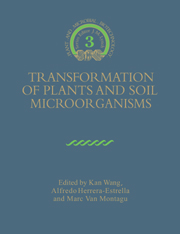Book contents
- Frontmatter
- Contents
- List of Contributors
- Series Preface
- Preface
- Acknowledgements
- Abbreviations and Terms
- Part I Transformation of Soil Microorganisms
- Part II Transformation of Cereal Crops
- Part III Transformation of Industrially Important Crops
- 8 Leguminous Plants
- 9 Spring and Winter Rapeseed Varieties
- 10 Sunflower
- 11 Forest Trees
- Index
8 - Leguminous Plants
Published online by Cambridge University Press: 04 August 2010
- Frontmatter
- Contents
- List of Contributors
- Series Preface
- Preface
- Acknowledgements
- Abbreviations and Terms
- Part I Transformation of Soil Microorganisms
- Part II Transformation of Cereal Crops
- Part III Transformation of Industrially Important Crops
- 8 Leguminous Plants
- 9 Spring and Winter Rapeseed Varieties
- 10 Sunflower
- 11 Forest Trees
- Index
Summary
Introduction
Many of the most important grain and forage crops of the world are legumes so there has been an interest in their tissue culture and transformation for many years. Since legumes are dicotyledons (dicots), they are in general very susceptible to infection by both Agrobacterium tumefaciens and Agrobacterium rhizogenes, so these systems have been used extensively.
Legumes in general and grain legumes in particular have been recalcitrant as far as plant regeneration from tissue culture is concerned. This has made many of the transformation techniques difficult, and so has delayed the overall progress. However, it is possible to transform the two most important crop legumes, soybean and alfalfa, and regenerate transformed fertile plants. Thus, we are now ready to attempt to improve leguminous crops using transformation. A review of legume transformation has been presented by Nisbet & Webb (1990).
In the following sections, we summarize many of the transformation studies that have been carried out with leguminous crops species and draw conclusions about the shortcomings and prospects for each. The species are divided into sections on Grain and Forage, based upon primary crop use.
Grain legumes
Soybean (Glycine max)
Soybean is a very important oil- and protein-producing crop, so many studies have been carried out with the goal of obtaining transformed plants. Transformation by Agrobacterium tumefaciens While most dicots, including legumes as described in other sections of this review, are very susceptible to A. tumefaciens, soybean plants do not form tumors very well when inoculated with virulent strains and there are large differences in responses found with different genotypes (e.g. see Owens & Cress, 1985; Byrne et al., 1987).
- Type
- Chapter
- Information
- Transformation of Plants and Soil Microorganisms , pp. 101 - 124Publisher: Cambridge University PressPrint publication year: 1995
- 1
- Cited by



